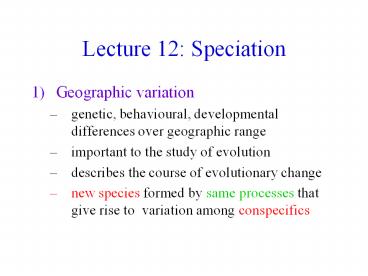Lecture 12: Speciation - PowerPoint PPT Presentation
Title:
Lecture 12: Speciation
Description:
new species formed by same processes that give rise to ... Heliconius butterflies Cougars. Superspecies (Artenkreis) Parus spp. Gasterosteus aculeatus ... – PowerPoint PPT presentation
Number of Views:214
Avg rating:3.0/5.0
Title: Lecture 12: Speciation
1
Lecture 12 Speciation
- Geographic variation
- genetic, behavioural, developmental differences
over geographic range - important to the study of evolution
- describes the course of evolutionary change
- new species formed by same processes that give
rise to variation among conspecifics
2
Patterns in Geographic Variation Among Species
- Parapatric different forms meet interbreed
- Sympatric different forms meet but dont
breed - Allopatric geographically separated never get
the chance to mate - Polytypic species spp. with several defined
subspecies (geographic races) - Superspecies monophyletic group of closely,
mostly allopatric species (i.e. used to be one
spp., usually post-mating isolation)
3
Polytypic species (Rassenkreis)
- Heliconius butterflies Cougars
4
Superspecies (Artenkreis)
- Parus spp. Gasterosteus aculeatus
5
Forms of Geographic Variation
- Cline gradient of variation in
genotype/phenotype - Types of Clines
- Concordant gt 1 characters vary along the same
transect - Discordant characters vary independently
- Shallow gradual changes in character
- Stepped abrupt changes in character
6
Concordant Clines
- e.g. Orioles
- Colour
- Enzyme frequencies
- West to east
- Pleiotropy may cause concordance
7
Discordant Clines
- e.g. Rat Snake
- Blotching
- Colour
- Striping
- Due to geographic variation in selection pressure
8
More Examples
- Gradual Cline
- CLOVER
- cyanide production
- ? N to S cline
- Balance costs benefits
- Benefit protection against herbivory
- Cost frost sensitivity
- Discordant Cline
- RABBIT TICKS
- body size ? S to N
- appendage size ? W to E
- Trade-off b/w fat storage desiccation
9
Famous Clines
- Bergmans rule
- warm-blooded spp.
- larger in colder environments
- Allens rule
- warm-blooded species
- shorter protruding body parts relative to body
size in colder - Glogers rule
- More darkly pigmented in more humid climates
10
- Variation Reproductive Isolation ? Speciation
- speciation requires isolating mechanism
- eventual genetic barrier to interbreeding
11
Speciation
- Speciation can be classified by geographic
- characteristics or genetics
- Allopatric speciation
- Parapatric speciation
- Peripatric speciation
- Sympatric speciation
12
Allopatric Speciation Model
13
Allopatric Speciation
- Best known easiest understood mode of
speciation - Lots of evidence
- Ring Species (Ensatina spp.)
14
Model Island Archipelagoes
- Invasion
- Divergence
- Reinvasion
1. 2. 3.
15
Recontact of Divergent Species
- Speciation complete no hybridization
- Speciation incomplete hybridization
- Hybrid Zones regions of 2? contact b/w
previously isolated popns w viable hybrids - Fitness of hybrids determines incidence of hybrid
zones - If reduced fitness isolation reinforced by
selection
16
Reinforcement model
- AA Aa aa
- selected against
- (low fitness)
- ?
- AA ? A
- Aa
- aa ? a
Fixation Speciation
Assortative mating
17
Problem
- If a is rare, selection against Aa removes it
from the pool - AA
- Aa ? AA
- aa
Fixation No Speciation
This genotype is uncommon
18
- Gene flow between divergent populations will
- - equalize gene frequencies
- - reduce isolation
- - make one species (hybrid zone)
- Reinforcement must act quickly because of
competing effects of gene flow isolation
19
Peripheral Isolate Model
- Mayr 1954
- founder effect
- peripatric speciation
- Observed local, isolated populations peripheral
to the main range are often divergent
20
Peripatric Speciation
- new environment homogeneous
- (few conflicting selective pressures)
- population small
- founded by few individuals
- low genetic diversity
- genetic drift
- must be no gene flow
21
Mechanism
- Genetic change in large popns is slow (gene
flow) - Faster in small populations (genetic drift)
- Epistasis synergistic effect of 2 loci on
phenotype (may help pass fitness valley) - Rapid speciation
- Evidence flycatcher
- lizards
- Model allows for non-adaptive speciation
22
Speyeria spp.































